Nikolas Lamb
Pix2Repair: Implicit Shape Restoration from Images
May 29, 2023Abstract:We present Pix2Repair, an automated shape repair approach that generates restoration shapes from images to repair fractured objects. Prior repair approaches require a high-resolution watertight 3D mesh of the fractured object as input. Input 3D meshes must be obtained using expensive 3D scanners, and scanned meshes require manual cleanup, limiting accessibility and scalability. Pix2Repair takes an image of the fractured object as input and automatically generates a 3D printable restoration shape. We contribute a novel shape function that deconstructs a latent code representing the fractured object into a complete shape and a break surface. We show restorations for synthetic fractures from the Geometric Breaks and Breaking Bad datasets, and cultural heritage objects from the QP dataset, and for real fractures from the Fantastic Breaks dataset. We overcome challenges in restoring axially symmetric objects by predicting view-centered restorations. Our approach outperforms shape completion approaches adapted for shape repair in terms of chamfer distance, earth mover's distance, normal consistency, and percent restorations generated.
Fantastic Breaks: A Dataset of Paired 3D Scans of Real-World Broken Objects and Their Complete Counterparts
Mar 30, 2023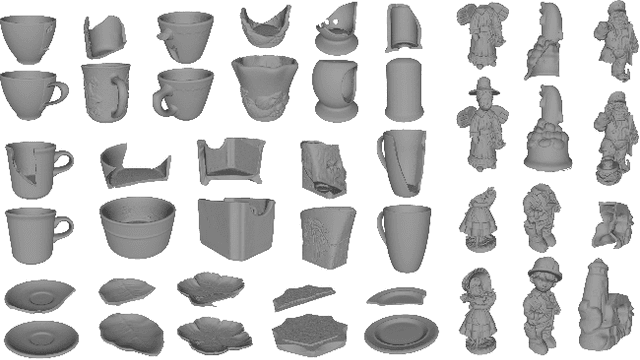

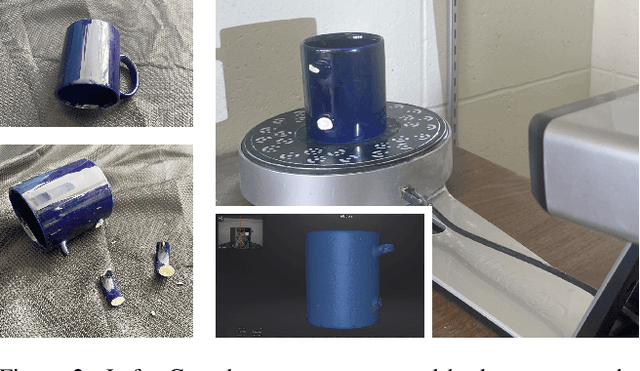

Abstract:Automated shape repair approaches currently lack access to datasets that describe real-world damaged geometry. We present Fantastic Breaks (and Where to Find Them: https://terascale-all-sensing-research-studio.github.io/FantasticBreaks), a dataset containing scanned, waterproofed, and cleaned 3D meshes for 150 broken objects, paired and geometrically aligned with complete counterparts. Fantastic Breaks contains class and material labels, proxy repair parts that join to broken meshes to generate complete meshes, and manually annotated fracture boundaries. Through a detailed analysis of fracture geometry, we reveal differences between Fantastic Breaks and synthetic fracture datasets generated using geometric and physics-based methods. We show experimental shape repair evaluation with Fantastic Breaks using multiple learning-based approaches pre-trained with synthetic datasets and re-trained with subset of Fantastic Breaks.
DeepJoin: Learning a Joint Occupancy, Signed Distance, and Normal Field Function for Shape Repair
Nov 22, 2022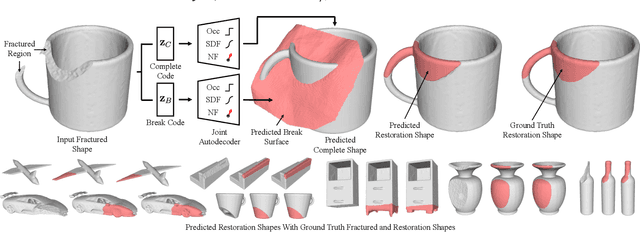


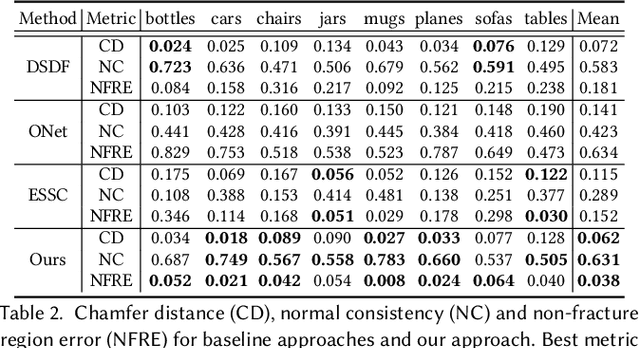
Abstract:We introduce DeepJoin, an automated approach to generate high-resolution repairs for fractured shapes using deep neural networks. Existing approaches to perform automated shape repair operate exclusively on symmetric objects, require a complete proxy shape, or predict restoration shapes using low-resolution voxels which are too coarse for physical repair. We generate a high-resolution restoration shape by inferring a corresponding complete shape and a break surface from an input fractured shape. We present a novel implicit shape representation for fractured shape repair that combines the occupancy function, signed distance function, and normal field. We demonstrate repairs using our approach for synthetically fractured objects from ShapeNet, 3D scans from the Google Scanned Objects dataset, objects in the style of ancient Greek pottery from the QP Cultural Heritage dataset, and real fractured objects. We outperform three baseline approaches in terms of chamfer distance and normal consistency. Unlike existing approaches and restorations using subtraction, DeepJoin restorations do not exhibit surface artifacts and join closely to the fractured region of the fractured shape. Our code is available at: https://github.com/Terascale-All-sensing-Research-Studio/DeepJoin.
DeepMend: Learning Occupancy Functions to Represent Shape for Repair
Oct 11, 2022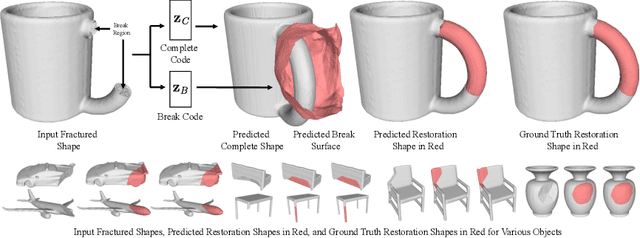

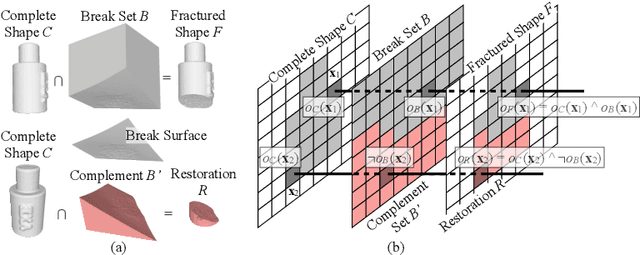

Abstract:We present DeepMend, a novel approach to reconstruct restorations to fractured shapes using learned occupancy functions. Existing shape repair approaches predict low-resolution voxelized restorations, or require symmetries or access to a pre-existing complete oracle. We represent the occupancy of a fractured shape as the conjunction of the occupancy of an underlying complete shape and the fracture surface, which we model as functions of latent codes using neural networks. Given occupancy samples from an input fractured shape, we estimate latent codes using an inference loss augmented with novel penalty terms that avoid empty or voluminous restorations. We use inferred codes to reconstruct the restoration shape. We show results with simulated fractures on synthetic and real-world scanned objects, and with scanned real fractured mugs. Compared to the existing voxel approach and two baseline methods, our work shows state-of-the-art results in accuracy and avoiding restoration artifacts over non-fracture regions of the fractured shape.
 Add to Chrome
Add to Chrome Add to Firefox
Add to Firefox Add to Edge
Add to Edge